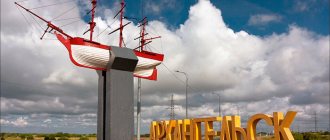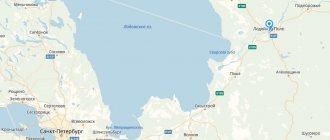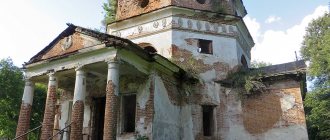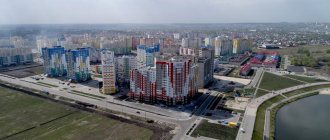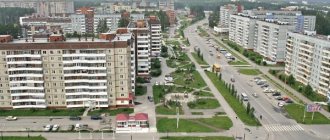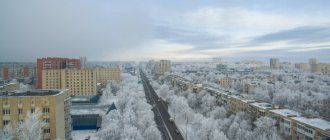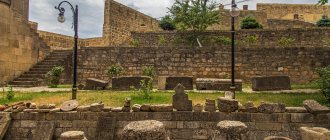We have symbolic places in Russia.
Even if you have never been there, the name itself is firmly imprinted in your heart. One of these places is located in the Belgorod region. This is the legendary Prokhorovka. It was here that the largest tank battle of World War II took place in July 1943. And in this essay I want to talk about the famous Tank Field.
Click on the photos and they will open in larger format
Content
- 1 Church of Peter and Paul (Prokhorovka)
- 2 Temple of Elijah Muromets (Beregovoe)
- 3 Temple of Equal-to-the-Apostles Methodius and Cyril (Malye Mayachki)
- 4 Church of the Ascension (Radkovka)
- 5 Temple of St. John the Evangelist (Kholodnoe)
- 6 Temple of Equal-to-the-Apostles Vladimir and healer Panteleimon (Vyazovoe)
- 7 Temple of the Epiphany (Luchki)
- 8 Church of the Life-Giving Trinity (Zhuravka)
- 9 Temple of the Exaltation of the Life-Giving Cross of the Lord (Petrovka)
- 10 Temple of Demetrius of Thessalonica (Raft)
Church of Peter and Paul (Prokhorovka)[edit]
On May 3, 1995, the bell sounded the news of the opening of a new spiritual shrine of the Fatherland. With an unprecedented gathering of people in Prokhorovka, the Peter and Paul Church, built with public funds in memory of those killed on the Kursk Bulge, was consecrated. The decisive event of the Battle of Kursk - the Battle of Prokhorov - took place on July 12, 1943, on the day of the Holy Apostles Peter and Paul. According to the canons of the Orthodox Church, the temple is named after them. A temple stood on the battlefield - a symbol of eternal grateful memory to the defenders of the Motherland. The lamp of the holy faith of Christ burns in it, a prayer ascends to heaven for the repose of those who laid down their souls for their faith and their native land, and “Many years…” sounds for those who are alive.
The 59-meter white stone temple was built in the best traditions of Russian architecture. Its composition resembles a lit candle. The white color of the Transfiguration, the color of the purity and nobility of souls worthy of eternal life, gives the temple a special solemnity. Chief architect of the project D.S. Sokolov.
Address:
Russia, Belgorod region, Prokhorovsky district, urban settlement Prokhorovka, Parkovaya street, 47
Telephone:
+7 (910) 325-67-97
Tank field
a sign at the very entrance to the Tank Field . And you immediately understand that this is not just a field, but the territory of a museum-reserve.
Nearby is a stela with the Decree of the President of the Russian Federation B.N. Yeltsin on the creation of the Prokhorovskoe Field museum-reserve. And from this place there is a beautiful view of the belfry.
The lawns on the field are decorated in the style of the St. George Ribbon.
From a distance the belfry looks like a lit candle. The four pylons (side walls) symbolize the four years of war. The golden sphere represents the sun and power, a symbol of statehood. And above her is the figure of the Most Holy Theotokos, intercessor and defender of Russia.
Inside the Belfry, under the drum, a bell weighing 3.5 tons is suspended. It sounds three times an hour , notifying with blows the great role of the three battlefields in the history of Russia.
- The first ringing reminds us of the heroes of the Kulikovo field, when Russia was freed from the Mongol-Tatar yoke.
- The second ringing is the memory of the Battle of Borodino, when the invasion of Napoleonic troops was stopped.
- The third ringing is the memory of the Battle of Prokhorov. It became one of the turning points in the fight against Nazi Germany.
There are a lot of symbols on this monument related not only to the tank battle of 1943, but also to the history of our country. You can read about this in a separate essay, which is dedicated to the Belfry on the Prokhorovsky Field.
Next to the Belfry there are busts of three Russian commanders. Dmitry Donskoy led the Russian army on the Kulikovo field, Mikhail Illarionovich Kutuzov - on Borodino, and Georgy Konstantinovich Zhukov - near Prokhorovka. Here it is, the connection of times!
Next to them is a stylized map depicting the territory of three military fields of Russia: Kulikov, Borodino and Prokhorovsky.
And behind them, in a vast space, there are tanks, self-propelled guns, and artillery installations.
Information plates indicate the main characteristics of combat vehicles and artillery pieces. This is what our famous “thirty-four” of 1943 was like.
In the depths of the field, among the trees, stands a tank number 213 with a guards badge on the left side . It is considered the very first monument on the Tank Field. In 1973, the tank entered the pedestal under its own power and froze forever at this height. There are several pictures of this tank in my archive. This is what he looked like in July 2014.
And this is a photo from April 9, 2021. As you can see, the side inscriptions on the tank, the information plate, and the lining of the pedestal have been updated.
There is an amazing story connected with this tank.
In November 2021, a reader from the Sverdlovsk region, Valery Vladimirovich Varov, came to my project. Since childhood, he knew that his father was a driver-mechanic on tank number 213. Valery Vladimirovich always watched newsreels and feature films in the hope of seeing his father’s combat vehicle.
And then, in the Yandex photo feed, he accidentally came across a picture of a tank with this number. By clicking on the link, Valery Vladimirovich went to the “Roads of the Soul” website. I wrote a comment and I replied.
We started correspondence. Valery Vladimirovich shared photographs from the family archive (they are in the comments after this article). We discussed many issues related to the Battle of Kursk. And at some point we realized that we definitely needed to go to the Tank Field.
We arrived in Belgorod: I by train from Vladimir, Valery Vladimirovich by plane from Yekaterinburg. On April 9, 2021, we met in Prokhorovka near tank number 213.
During my stay in Prokhorovka, many interesting and rather unexpected facts related to this tank were revealed. Valery Vladimirovich shared this information in an interview that he gave to our project.
Next to the pedestal on which the tank stands, in 1943 there was a defense line.
On the tank field you can see the legendary Katyusha.
At the other end of the field next to the track there is a cafe "Dugout" .
The menu in the cafe is also “front-line”.
Temple of Elijah Muromets (Beregovoe)[edit]
With the blessing of Archbishop John of Belgorod and Stary Oskol, for the 60th anniversary of Victory in the Great Patriotic War, in the fall of 2004, construction began on the Church of St. Elijah of Muromets in the village of Beregovoe, Prokhorovsky district. Previously, there was no temple in the village.
On September 26, 2005, services began in the temple.
On May 9, 2006, a solemn consecration took place. The day of consecration and the patron of the temple were not chosen by chance, but in honor and memory of the ancestors who stood at the origins of Orthodox Rus', who served the Fatherland with faith and truth.
Address:
309041, Belgorod region, Prokhorovsky district, village. Beregovoe.
Email:
Official website of the temple
Preface
In 1995, the year of the 50th anniversary of the Victory of the Soviet Union in the Great Patriotic War, the Tank Field memorial complex was opened. I was lucky enough to visit there several times. The fact is that our dad, Anatoly Grigorievich Trunov, comes from exactly those places. Therefore, every time we go to his homeland, the village of Vyazovoe, we pass Prokhorovka.
A lot has been written about the Battle of Kursk. This information can be easily found on the Internet if you know where to look. Therefore, in this note I will not talk about the battle itself, nor about the history of the creation of the museum complex. Let's just walk through the Tank Field.
A little clarification. This essay was published in May 2021. In April 2021, I had the opportunity to visit Prokhorovka again. After the trip, I made additions to the article and added several new photographs.
- Tank field
- Victory Park
- Memorial complex "Third Military Field of Russia"
- "No one is forgotten, nothing is forgotten"
Church of the Ascension of the Lord (Radkovka)[edit]
The stone Ascension Church in the village of Radkovka was built in 1808.
This is the only ancient temple in the Prokhorovsky district that survived the years of Soviet power. However, this temple was closed in the 1930s.
Worship there resumed during the Great Patriotic War.
The temple is still in operation today. It is an architectural monument.
Address:
309012, Belgorod region, Prokhorovsky district, village. Radkovka.
Email:
Official website of the temple
Museum-Reserve "Prokhorovskoye Field"
The military-historical complex is located on the site of the Prokhorovsky tank battle. Its area is 5000 square meters. Here are some memorable objects.
Monument to Soviet tank crews “Height 252.2” (1973). In 1971, on the twenty-fifth anniversary of the victory, veterans of the Kursk Bulge met in Prokhorovka. Among them was General Rotmistrov. At his suggestion, they decided to erect a monument in memory of the feat of Soviet tank crews. Five kilometers from Prokhorovka, a T-34-85 tank was installed on the “Height 252.2 meters” hill. It became the first object of the museum.
The observation post of General Rotmistrov (1973) has been preserved since the Great Patriotic War. From here in July 1943 the general commanded the troops. This is a dugout with two narrow viewing slits, through which a view of the Prokhorovskoe field opens up. The entire furnishings were recreated from genuine items from the war era.
The memorial sign of senior lieutenant Pavel Shpetny (1981) was installed on the hill “height 226.6” near the Psel River. Here in July 1943, a platoon of armor-piercing soldiers under the command of Pavel Shpetny fought with the SS tank division “Totenkopf”. The Germans threw seven Tiger tanks at nine people from Shpetny’s platoon. Shpetny's platoon was killed, but destroyed all seven enemy vehicles. The lieutenant knocked out the last Tiger by throwing himself under it with a grenade. The lieutenant was awarded the title “Hero of the Soviet Union” posthumously.
Military burial place of soldiers and officers “Khutor Storozhevoye” (1994). In October 1941, the farm was occupied by German troops. Until the summer of 1943, fighting took place here.
The German command ordered the prisoners of war to dig a ditch in the collective farm stables for the burial of Soviet soldiers. There are 1,436 people in the mass grave.
In the post-war years, residents erected a memorial obelisk over the grave and took care of the grave. In 1983, the obelisk was replaced with a marble monument, and in 1994, the “Worship Cross” memorial by sculptor Vyacheslav Klykov was installed at the burial site.
The monument “Belfry on the Prokhorovsky Field” (1995) is a monument by sculptor Vyacheslav Klykov. These are four pylons that converge in a dome at a height of 59 meters. An alarm bell weighing 3.5 tons was placed under the dome. The dome of the belfry was decorated with a seven-meter gilded statue of Nike, the goddess of victory. The walls of the pylons were decorated with reliefs.
The Church of the Holy Apostles Peter and Paul (1995) is a single-domed white stone church, which was built according to the design of Dmitry Sokolov with donations from local residents. The names of soldiers who died in the battles near Prokhorovka are engraved on the walls of the temple. The temple is operational, and services are held here on Sundays and church holidays.
The cultural and historical center of the Third Military Field of Russia (2005) is a two-story building for tourists and foreign delegations. The center has a conference hall, a hotel with 60 rooms and a meeting room. Photo exhibitions and military-patriotic readings “Prokhorovskoye Field” are held here.
The building houses Nikolai Ryzhkov’s library with 80,000 books. Anyone can get into the library; subscriptions are free.
In the courtyard of the center, a sculpture “To the Warriors Who Fell on the Prokhorov Field” by Friedrich Sogoyan was installed.
Museum of Military Glory of the Third Military Field of Russia (2010). In the courtyard and in the museum building you can see:
- six commemorative steles and two sculptures by Friedrich Sogoyan - “Tank landing” and “Tank battle of Prokhorovka. Ram";
- reconstruction of Soviet and German fortifications: trenches, trenches, tank shelters and infantry dugouts;
- weapons and equipment of soldiers of two armies, samples of tanks, guns and mortars, authentic military maps and a model of the Belgorod region;
- a cinema hall with 90 seats, where war newsreels are shown;
- cinematic composition “War Machine”;
- Tank simulator is a multimedia object that allows you to feel like a pilot of a T-34 tank.
In addition to the history of wartime, the museum will tell about the history of the Belgorod region in the pre- and post-war times; a separate hall of the museum tells about the history of the settlement of these lands, the life, culture and traditions of the inhabitants.
Tankodrome (2015) - a tank training ground next to the Museum of Military Glory. The area of the route is 11 hectares.
The only demonstration site in the country.
The tankodrome's fleet includes armored personnel carriers, infantry fighting vehicles, armored reconnaissance and landing vehicles. All the vehicles were provided to the museum by the Ministry of Defense. Reconstructions of infantry and tank battles during World War II are carried out at the training ground.
For those who wish, maneuvers are organized in an armored personnel carrier or infantry fighting vehicle - they are transported through an obstacle course throughout the training ground.
Tribunes were installed at the training ground for spectators.
Museum of Armored Vehicles of the Red Army (2017) with an area of 2830 square meters. While walking around the museum, you can learn the history of siege and tank technology from antiquity to the present day. In the antique hall there are models of siege weapons on a scale of 1:2 and a model of Leonardo da Vinci’s tank.
In the hall of armored vehicles from the Great Patriotic War, an installation was installed about the creation of a tank from a drawing to a finished vehicle. On the screen, with the help of animation, they showed how a drawing appears, and a finished combat vehicle “moves out” of the drawing.
A separate room is occupied by the “Factory” installation. Here they showed the full tank production cycle - drawings, machines for making cast and stamped parts, conveyors for assembling units.
Another room talks about modern tank building. Models of the latest weapons are presented here.
An audio guide leads a tour of the halls.
Church of St. John the Evangelist (Kholodnoe)[edit]
The name of the village, according to legend, was given by numerous cold springs that still flow from the ground. Until 1814, Kholodny was part of other parishes in the region. The temple that previously operated in the village was destroyed in 1962.
The new temple was built by the Belgorod ZhBK-1 plant using the technology of assembly from large-sized structures developed by this enterprise.
On May 29, 2002, in the village of Kholodnoye, Archbishop John of Belgorod and Stary Oskol consecrated a newly built church in the name of the Apostle and Evangelist John the Theologian.
Address:
309026, Belgorod region, Prokhorovsky district, village. Cold.
Telephone:
+7(47243) 2-26-35
Official website of the temple
Temple of Equal-to-the-Apostles Vladimir and healer Panteleimon (Vyazovoe)[edit]
In the village of Vyazovoe in 1840 a temple was built in the name of St. Nicholas. The ringing of the bells of this temple could be heard 20 kilometers away. At the beginning of the 19th century, in the Vyazovsky forest, an icon of the holy great martyr and healer Panteleimon appeared on a water source.
After the October Revolution of 1917, the temple was closed and destroyed in the 40s. At the same time, the chapel was also destroyed. The source itself was covered with earth several times, but water made its way nearby, and people secretly came and came here.
In 1992, with the active participation of local residents, construction of a new St. Nicholas Church began, which was completed in 1995. But soon this temple was destroyed by fire.
The newly built temple was consecrated by Archbishop John of Belgorod and Stary Oskol in the name of the Holy Equal-to-the-Apostles Prince Vladimir and the Great Martyr and Healer Panteleimon on November 23, 2003.
On May 8, 2005, Archbishop John of Belgorod and Stary Oskol consecrated a chapel in honor of the Vladimir Icon of the Most Holy Theotokos, a new chapel over a spring in the forest in the vicinity of the village - in the name of the Holy Great Martyr and Healer Panteleimon, and a bathhouse at the spring.
Address:
309014, Belgorod region, Prokhorovsky district, village. Vyazovoe.
Telephone:
+7(47242) 2-83-42
Official website of the temple
Upper part of the belfry
The belfry is crowned with a seven-meter tall figure of the Virgin Mary. She holds the Veil in her hands . The Mother of God seems to cover both those who were on this field during the tank battle and those who come to honor the memory of the fallen. The Virgin Mary at the very top of the belfry is a vivid symbol of the powerful spiritual protection of Russia
The gilded sphere on which the figure of the Virgin Mary is mounted symbolizes the power. And this, as we remember, is one of the symbols of statehood. The sphere rests on a cylindrical drum made of white marble. He is surrounded by a ribbon on which is carved in gold letters in Church Slavonic a phrase from the Bible: “Greater than all love, no one has, but who would lay down his life for his friends” - “There is no greater love than to give your life for your friends.”
The photo on the right shows that the lower part of the drum is surrounded by a gilded laurel wreath , a symbol of valor and glory.
Church of the Intercession on the Nerl
We have an essay on the project dedicated to one of the masterpieces of architectural architecture. This is the Church of the Intercession on the Nerl - the first architectural monument of Ancient Rus', dedicated to the Feast of the Intercession of the Blessed Virgin Mary.
Temple of the Epiphany (Luchki)[edit]
Since 1832, a stone Epiphany Church with one altar functioned in the village - in the name of the Baptism of the Lord. At the beginning of the 20th century, there were 1,427 people in the church parish. Unfortunately, the old stone church in Luchki, which regularly served the village residents for almost a century and a half, has not survived - damaged during the war, it was dismantled in the mid-50s.
The new church in Luchki was built in six months. The main initiator of the construction of the Epiphany Church was the Luchkovites themselves. The temple is designed for 50-60 parishioners.
On June 22, 2021, a foundation stone was installed on the site of the future church, and on November 5, the temple was consecrated by Bishop Sophrony of Gubkin and Grayvoron.
Address:
309032, Belgorod region, Prokhorovsky district, village. Luchki, Tsentralnaya street, 9.
For whom the Bell Tolls
A real alarm bell . We know that previously it was the bells that announced fires and floods, attacks by enemies and victories over them.
Many articles and booklets that talk about the belfry say that the bell on Prokhorovsky Field rings every 20 minutes. In April 2021, we spent several hours in this place, but for some reason I did not hear the bell ringing.
Why does the bell ring three times an hour ? In memory of the greatest battles that took place on three battlefields of Russia.
The first ringing is dedicated to the Kulikovo Field , where the Russian army defeated Khan Mamai. The second ringing is dedicated to the Borodino Field , where the decisive battle of the Patriotic War of 1812 took place. And the third ringing of the bell sounds in memory of the Prokhorovsky Field , where the tank battle took place in July 1943.
Busts of three generals are installed next to the map of the three fields . It was they who led our troops in these battles: Dmitry Donskoy, Mikhail Illarionovich Kutuzov and Georgy Konstantinovich Zhukov.
Now let's look at the relief compositions of the Victory Monument.
Church of the Life-Giving Trinity (Zhuravka)[edit]
A stone church in honor of the Life-Giving Trinity was erected in the village of Zhuravka in 1869.
In 1938, the Holy Trinity Church was devastated, and during the Great Patriotic War, in the battles of the Battle of Kursk, it was completely destroyed. The surviving building of the parochial school was converted into a church in 1992.
The new Church of the Holy Trinity in Zhuravka was consecrated on July 8, 2007 with the blessing of Archbishop John of Belgorod and Stary Oskol.
Address:
309010, Belgorod region, Prokhorovsky district, village. Crane.
Telephone:
+7(47242) 4-56-45
Email:
Official website of the temple
Prokhorovka. History of the village
In 1989, after visiting the Baltic states, I had the idea to make a model of the village of Aleksandrovsky at the beginning of the century. The fact is that in Estonia there were a lot of models of fortresses. And I thought that it would be nice to do such a wonderful miracle here. To do this, it was necessary to collect information, which was exactly zero. It’s good that those who well remembered pre-war Prokhorovka were alive. And from the beginning of the 20th century until the 40s, little changed in architecture. Only the owners of the houses have changed. In Prokhorovka at the beginning of the 20th century there were several streets. Central (current Sovetskaya Street) was divided into several sections. From the station to the turn to the former poultry farm, part of the street was called Aleksandrovka, further to the park - Kozlovka, and from the park to the end of the village - Mordovka. The area around Sadovaya Street was called Zelenovka. The current Oktyabrskaya street was Maslovka, and Belousovka the first and Belousovka the second stretched towards the brick factory. From the station to the west there was Nakhalovka. Many of these names have survived to this day.
I started my research with the former Zelenovka. I was lucky to meet Ladygina Ekaterina Yakovlevna. Her mother worked for the landowner Pushkarev, and Ekaterina, while still a child, helped her. From her I heard that Sergei Germanovich Pushkarev lives in America. Vera Petrovna Chursina told a lot of interesting things. Most of the information came from Boris Mitrofanovich Chursin. In general, we were lucky that the museum had such a friend. This is a person who loves and knows his village and fellow countrymen. He kept names, surnames and facts in his memory. Several times we redrew the plan, which began to acquire details. This is how the history of the village appeared. Not archival, but our own, woven from legends and memories.
We couldn’t afford the model financially, and I asked the artist Lyudmila Ospischeva to paint a picture, which was shown in the museum’s local history exhibition for 15 years. 30 years have passed. There is no one else to ask and this work has already become a story that I decided to share with you, dear readers.
So.
“In the late 60s, a railway was built between Kursk and Kharkov. At 96 versts from Kursk, not far from the settlement of Prokhorovka, Oboyansky district, a railway station was established in a field with the name of this village assigned to it. In the first years there was nothing around this station, and then, over time, when this station began to acquire the importance of a point of prominent departure and receipt of various kinds of products and trade for both Korochansky and other adjacent counties, near this station Mostly commercial people began to settle. These settlers were from different districts, and, as they say, mainly came from the village of Razboiny, which lies not far from this area, which is why this new village retained and appropriated the same name for some time. From year to year this village grew and then sought to be renamed the village of Alexandrovsky. At present, as everyone knows, it represents a very respectable and lively trading area with a population of up to 1,100 people and, as an exclusively trading village, is distinguished by its apparent prosperity. renaming the village Alexandrovsky Posad.” The request of Count V. Kreutz was granted and from that time on our village is designated in documents as Aleksandrovsky Posad. (Posad is an urban-type settlement.) The station continued to bear the name Prokhorovka. This double name remained until 1968. There were many settlements in Russia bearing the name Alexandrovsky. Most were named after Tsar Alexander. Our village is no exception. On November 18, 1869, His Imperial Highness the future Tsar Alexander III traveled to Kursk from Kharkov by rail. After ascending the throne, he also repeatedly passed through the Prokhorovka station. Prokhorovskaya rumor claimed that on one of the passages, the tsar went out onto the platform in Prokhorovka while the water was being filled. Be that as it may, our village for a long time bore the name of Alexander III.
The village was being improved. The access roads to the station were paved, a showcase was installed at the station to display products, and a telegraph was installed. In 1883, the St. Nicholas Church was consecrated in Prokhorovka. Since then, the patronal holiday has been St. Nicholas (winter). After some time, another throne was built in the church - in honor of Saint Raisa. And it was like that. The merchant Nebytov E.P.’s daughter Raisa died. She died on Easter. He asked to bury his daughter in the narthex of the church, and he, in turn, donated a large sum of money in order to organize a throne in honor of Saint Raisa. And so they did. Since that time, the Prokhorovites have celebrated two patronal holidays. The priest Ivanov Konstantin Ilyich served in the church for many years. A two-class parish school was opened at the church, where Ivanov and his wife taught. The priest died shortly before the revolution. After the revolution, the parochial school was renamed the Alexander Soviet School, where the widow of the priest Alexandra Fedorovna Ivanova and Maria Porfiryevna Olovnikova (daughter of the merchant Porfiry Afanasyevich Olovnikov) continued to teach.
Prokhorovka was built up with beautiful merchant mansions. They were located mainly in the central part of the village, which was called Aleksandrovka.
Directly opposite the station was the house of Andrei Eliseevich Mezentsev. Mezentsev owned barns valued at 2,000 rubles and an egg warehouse valued at 1,500 rubles. After the revolution, the building housed a hospital. During the occupation, Nazis were treated here. Destroyed during bombing in July 1943. Mezentsev's house exactly corresponded in architecture to the house of Ivan Fedorovich Alekseev, which has survived to this day (150 Sovetskaya St.). Alekseev was the richest merchant in Prokhorovka. He owned property at the station worth 6,500 rubles (a barn for storing bread, a warehouse for tar and kerosene, a bird feeder, an egg warehouse). During the war, the house housed the District Executive Committee, then a music school, now the People's Court. Next to the house, Alekseev built a store with glass display windows, where he exhibited his products. After the revolution, Torgsin was there. Anton Iosifovich Molchanov, who owned a tavern at the station, also owned two houses that were located next to Mezentsev’s house. Immediately after the revolution, the RKSH and the Collective Farmer's House were located in these houses. On the opposite side is the station building with station buildings - warehouses and barracks, some of which exist to this day. On the site of the former cinema and House of Culture (Sovetskaya St. 69, 71) there were two Fedotov houses, one brick and the other wooden. Next came houses of similar architecture by Alexander Danilovich Panikhin and Pyotr Andreevich Rudkovsky. On the site of the former bank (Sovetskaya street 83) there was the house of Ivan Konstantinovich Dushechkin. There was also a shop in the house where they sold tar. After the revolution, there was a bank in this house. Probably someone else remembers the old savings bank building. A German family lived there and before the revolution a tragedy occurred in the house. When the owner of the house left on business, members of his family - his wife and two daughters - were killed. On the site of the former school workshops (2 Sadovaya Street) the Sokolovs’ house was located. And then there was a large two-story mansion of the Dyakonovs, which housed a school after the revolution. The old cellars of the deacon's house in the school garden have survived to this day. We've all been there. I still remember the vaulted ceilings and beautifully laid out niches. There has long been a legend that the basements of Prokhorov’s mansions were connected by underground passages. I will say right away that there was no reason for this, but we are all lovers of adventure, so we willingly believe in everything mysterious. Father and son Modlinsky lived in the village, whose houses still stand today. Alexander Andreevich Modlinsky lived in a house at 101 Sovetskaya Street, and Nikolai Alexandrovich lived at 139 Sovetskaya Street. By the way, during the occupation Nikolai Modlinsky came to Prokhorovka, walked along the street, and entered the house. But he left immediately that same day. On the site of the old “small” school (113 Sovetskaya St.) the house of Vasily Andreevich Derebizov was located.
Many Prokhorovites of the middle generation remember the old house, which was located in the center of the village (near house No. 204 on Sovetskaya Street). At the end of the 70s of the last century it burned and was then dismantled. This house was about 100 years old and the large and friendly family of German Osipovich Pushkarev, a local notary, lived in it before the revolution. After the revolution, the whole family went to Kharkov. Sergei Germanovich Pushkarev stayed in Prokhorovka the longest. On March 15, 1918, Pushkarev left Prokhorovka, as it turned out, forever. By rail he reached the Kustarnaya (now Sazhnoye) station, where he was met by a German border patrol. Sergei Germanovich served in the White Army, and then became a well-known specialist in Russian history abroad. Having left Russia once and for all, Pushkarev carried his love for the Motherland throughout his life. As a gift to us, Prokhorovites, he left the book “Memoirs of a Historian,” where he describes his life in our village, which he never forgot.
After the revolution, the Prokhorovsky breeding farm was organized on the site of Pushkarev’s former estate. At the beginning of the century, the Pushkarevs planted an oak grove. Now it has been restored and some trees remember Pushkarev himself. I kept in touch with Boris Sergeevich, the son of Sergei Germanovich. He lived near New York. The Pushkarev family ended there.
The abundance of greenery is striking in the picture. This is not an artist's invention. Indeed, the village was buried in fruit and berry gardens. This attitude existed for the entire Korochansky district, which included our village. It is no coincidence that there are apples on the coat of arms of the city of Korocha. Until about the 90s, there were still remains of these gardens in the courtyard of the District Party Committee, along Sovetskaya Street. Coming home from school we always picked apples. Then they said that the apples along the road were harmful. May be. Don't know. But definitely no one got sick from it.
Dear readers of my page, we can continue the topic of the history of our village and the story of people who left good memories of their deeds, if you are as interested in this as I am.
Temple of the Exaltation of the Life-Giving Cross of the Lord (Petrovka)[edit]
The wooden Church of the Exaltation of the Life-Giving Cross of the Lord became the first church built in Petrovka. It was erected unusually quickly - in less than nine months. On May 8, 2010, the temple was consecrated by Archbishop John of Belgorod and Stary Oskol.
A beautiful church made of logs, opened in honor of the 65th anniversary of the victory in the Great Patriotic War of the Russian people, rose above the expanses of the surrounding area right in the center of the village, on a hill, from where the ringing of its bells can now be heard far, far away, echoing the bells churches in Vyazovoe, Radkovka, Zhuravka. The temple is located next to the mass grave of soldiers who died during the war for the liberation of their land, and as a symbol of the eternal memory of the fallen, it will always remind us of the great love for which they gave their lives “for their friends.”
Address:
309013, Belgorod region, Prokhorovsky district, village. Petrovka.
Email:
Official website of the temple
Victory Park
Victory Park, which is adjacent to the Tank Field, was created quite recently. Do you recognize the model of the Reichstag with the Victory Banner raised above it? This is a 2021 photo.
Now the layout of the Reichstag roof looks like this.
In 2005, an apple orchard was founded near Victory Park.
We find ourselves on the central alley of the park.
There are steles on it telling about the bloody battle on the Kursk Bulge.
In Victory Park there are many monuments dedicated to the participants of the tank battle near Prokhorovka on July 11-12, 1943.
In the photo on the left is a monument to "Women of War" , in the photo on the right - to "Soldier Warrior" .
Monument to Soviet commanders who led the tank battle near Prokhorovka: I.S. Konev, A.M. Vasilevsky, N.F. Vatutin, K.K. Rokossovsky.
Monument to the commanders of the armies who participated in the Battle of Prokhorov: P.A. Rotmistrov, V.D. Kryuchenkin, A.S. Zhadov.
Here are two more monuments - “Lieutenants of War” and Pavel Ivanovich Shpetny.
of Lieutenant Borisov , who stopped several enemy tanks, is immortalized in Victory Park
The central path leads to the chapel, built at the expense of the Ryzhkov family.
The path from the chapel leads to the “Farewell” sculptural group. And I immediately remember the immortal lines of Konstantin Simonov: “Wait for me and I will return, just wait a lot...”.
A fragment of a military camp has been recreated nearby .
Here you can see models of trenches and dugouts.
The Prival cafe is located very close by
How can one not remember Vasily Terkin?
The power of the native land
I travel a lot. Somewhere I go with a guide, often on my own. In any case, I “scan” the space around me at all 360 degrees. That is, not only the objects that the guide talks about, but also much more come into view. Ordinary tourists are unlikely to pay attention to such “little things”, but my eyes already automatically read the space. I wrote about this in the essay “Tuning fork for traveling or how to tune into a place.”
So it was this time. When you arrive at the Tank Field, pay attention: in the place where the belfry rises and the tanks stand, there are no trees. And they are in Victory Park. And most of these trees grow in a very interesting way - several trunks from one root.
I have repeatedly heard from different people that this is one of the signs of a Place of Power. I think it was not for nothing that this particular field was chosen for the battle. The most powerful energy support from our native mother earth!
Memorial complex "Third Military Field of Russia"
A few kilometers from the Tank Field and Victory Park is Prokhorovka itself. And there is something to see there too.
In 1995, for the 50th anniversary of the Victory, in memory of those killed in the tank battle on July 12, 1943, the Church of the Holy Apostles Peter and Paul was erected in Prokhorovka. Next to the temple is the “Bell of Unity” , a symbol of friendship of three fraternal peoples - Russian, Ukrainian and Belarusian.
The cathedral was built in just a year using public donations. The temple has an interesting architectural element called “kokoshnik” . Every time I see kokoshniks on this temple (and I’ve been to Prokhorovka several times), a strange feeling comes over me from within. It’s as if the eyes of the soldiers who did not return from that terrible battle look straight into the soul.
In summer, the temple area is literally buried in flowers. Nearby there is a clergy house with a Sunday school and a library.
is located nearby .
In 2021, I saw a stele installed near the Cathedral of Peter and Paul. It contained a list of fronts and armies that took part in the Battle of Kursk. It’s strange, but in 2021 I no longer found this stele in its original place. Can you please tell me where it was moved?
The sculptural group “Taran” is located in front of the entrance to the memorial complex “Third Military Field of Russia”.
It has been more than 70 years since the battle ended. But to this day, finds from the war can still be found on the Prokhorovsky field. A few years ago they lay next to the museum building.
Here you can see German military vehicles Opel and Hanomag.
Behind the museum building there is a reconstructed fragment of Soviet and German defensive fortifications . They consisted of trenches, trenches, communication passages, platforms for guns and shelters for tanks. A real dugout is built into the trench system!
Now new museums have appeared in Prokhorovka - the Museum of Armored Vehicles and the Museum of Weapons.
I advise you to take a look
More detailed information about the State Military Historical Museum-Reserve “Prokhorovskoye Field” can be found on its official website.

